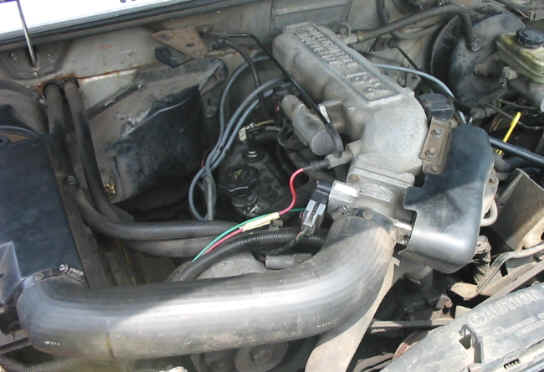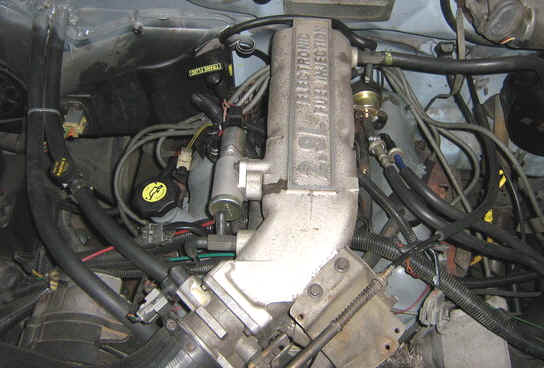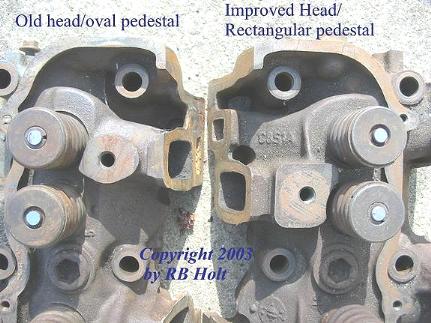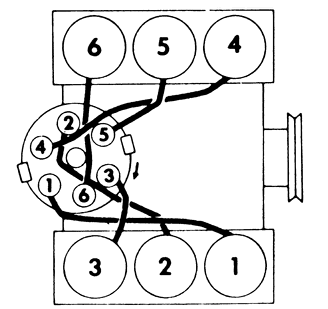

The Ford Cologne 2.9L V6 is a 60° cast iron block V6 engine built by the Ford Motor Company in Cologne, Germany, hence the name. Over the years, the Cologne V6 was available with engine displacements of 1.8, 2.0, 2.3, 2.4, 2.6, 2.8, 2.9 and 4.0 litres. All except the Cosworth 24v derivative and later 4.0 litre sohc engines were pushrod overhead valve engines, with a single camshaft between the banks.
Originally, the Cologne V6 was installed in cars intended for Germany and continental Europe, while the British “Essex” V6 was used in cars for the British market. Later, the Cologne V6 largely replaced the Essex V6 even for British-market vehicles. These engines were also used in the United States, especially in compact trucks.
The 2.9 L shares the same basic design as the 2.8 L model, bar a few subtle differences. The camshaft is chain-driven rather than gear driven, so it rotates in the same direction as the crankshaft. The arrangement of the exhaust valves is different, eliminating the “Hot-Spot” that existed on the 2.8 L model. The cylinder heads also sport a more conventional three-port exhaust manifold. Output was rated at 140 hp @4600 rpm for the Light trucks (1986-92 Ranger & 1986-90 Bronco II) and 144 hp @4800 rpm for the Merkur Scorpio in the US market and anywhere from 150 to 160 hp for the European Market.
Bore was 93 mm (3.7 in) and stroke was 72 mm (2.8 in) for a total displacement of 2.9 L (2935 cc/177 in³).
In Europe, this engine was commonly fitted with the Bosch L-Jetronic fuel injection system, married to Ford’s EEC-IV engine management. Because of this difference over the 2.8 L model, this version was a more popular candidate for after market modification (typically turbocharging) from such well known companies as Janspeed and Turbo Technics.
North American 2.9 Reliability:
The North American version of this engine suffered from several serious reliability issues over its lifespan.
Cylinder head cracking was common in early models. Compared to the relatively stout European heads, the North American 2.9 had apparently been subject to a reduction of material around the valve stem guides and rocker shaft mounting pedestals. Some engines would suffer from this failure after overheating only once. Most common symptoms are clean spark plugs, white exhaust smoke when warm, low compression on one or more cylinders, and “snot” on the oil cap or dipstick. Sometimes the “Snot” can just be condensation, so make sure the Engine is warm before checking. The best course of action is to drain the oil, pull the heads, and have them magnafluxed to make sure you have a crack, if you do have a crack, DO NOT RUN THE TRUCK, coolant in the oil toasts crankshaft bearings, requiring a total rebuild. If the truck isn’t run to long than you can probably get away with just heads.
The cylinder heads underwent a redesign for the 1989 model year, receiving additional material in problem areas, largely eliminating this specific failure. These head casts are commonly printed with the “89TM” designation. After-market heads are also available from World Products, with similar design improvements to the early OEM design.
 |
 |
Note the straighter valve cover mating surface on the improved heads. That is why old-style valve covers tend to leak on the newer heads. New valve covers have a turned-up flange, while the old-style valve covers have a turned-down flange. The important feature, as far as resistance to cracking is concerned, is that the improved heads are identified by the rectangular shaped rocker pedestals, while the old-style heads have oval pedestals.
Additionally, oiling problems were common, and added to the poor reputation of the North American 2.9. Many poorly maintained or high mileage engines exhibit serious valve train noise. This problem is due to a number of design faults. Valve train oil pressure was entirely dependent upon a supply fed through the two center cam bearings. Even slight bearing wear could cause complete loss of oil pressure to the hydraulic valve lifters, rocker shaft, and rockers. Excessive internal “bleeding” through the half-moon camshaft thrust plate also contributed to this, though this can be remedied by reinstalling the thrust plate in an upside-down position. This condition is sometimes mistaken for ticking fuel injectors. This condition isn’t a cause for alarm unless it does it very loudly or after long freeway trips. If it does have the oil pressure checked, it could be low.
In the event that a cylinder head crack occurs, coolant can often enter the crankcase, contaminating the oil. This quickly led to cam bearing damage, triggering valve train oil pressure loss. As a result, these two design faults led to catastrophic engine failure in many North American 2.9s.
Valve covers have been known to leak. Other than making the engine look nasty and smell nasty, these pose no danger. Some claims have been made of the motor catching fire because so much oil leaked on the exhaust, but this is rare. Replace with Fel Pro “Rubber” or Fel Pro “Blue” and leaks should be taken care of.
Regardless of these problems, many of these engines are still on the road in the US, and when maintained properly, are highly reliable powerplants. Use of synthetic oil and proper cooling system maintenance is essential if owners of early-model 2.9s wish to avoid trouble.
The 2.9L co-existed alongside the 3.0L, the Engine which replaced it, until 1992, when Ford introduced a “More Refined” Ranger. The 2.9L wasn’t a refined engine like the 3.0L “Vulcan”. It was rough, noisy, and crude. The 3.0L was none of these things so it replaced the 2.9L in 1993. Even with its meager low end torque (compared to the 2.9L) it still is the only Small V6 offered in the Ranger, next to the Big Brother 4.0L. The 4.0L is related to the 2.9L however, so in a way it still lives on. The 3.0L is in NO WAY related to the 2.9L V6 Engine.
Ford Ranger:
The 2.9L V-6 was offered in the Ford Ranger from 1986-1992.
|
Specifications |
|
| Engine Family | Cologne |
| Engine Displacement (Cubic Inches) | 177 |
| Cylinders | 6 |
| Arrangement of Cylinders | “V” Shape |
| Bore x Stroke | 3.66 x 2.83 |
| Compression Ratio | 9.0:1 |
| Valvetrain | Pushrod Overhead Valve |
| Fuel System | MPFI (Multiport Electronic Fuel Injection) |
| Fuel Pressure | 30-40psi |
| Horsepower | 140hp @ 4600rpm |
| Torque | 170hp @ 2600rpm |
| Oil Pressure | 20psi @ warm Idle 55psi @ 2000rpm |
|
Tune Up |
|
| Spark Plug | AWSF-42C |
| Spark Plug Gap | 0.044 |
| Ignition Timing | 10 degrees BTDC |
| Firing Order | 1-4-2-5-3-6 |
| Distributor Rotation | Clockwise |
|
Capacities |
|
| Oil Capacity With Filter Change | 5.0 quarts |
| Oil Capacity Without Filter Change | 4.0 quarts |
| Cooling System Capacity (Quarts) | W/AC- 7.2 / W/O AC 7.8 |
|
Torque Specifications |
|
| Cylinder Head | Torque in 3 steps [1st (22ft-lbs), 2nd (51-55ft-lbs), 3rd (Turn 90 degrees)] |
| Main Bearing Bolts | 65-75ft-lbs |
| Rod Bearing Bolts | 19-24ft-lbs |
| Crankshaft Pulley Bolts | 85-96ft-lbs |
| Flywheel to Crankshaft Bolts | 47-52ft-lbs |
| Intake Manifold | 15-18 ft-lbs [5-steps (hand start & snug) (3-6) (6-11) (11-15) (15-18) (Repeat 15-18 after warm up)] |
| Exhaust Manifold | 20-30ft-lbs |
|
Valve Specifications |
|
| Seat Angle Degree | 45 |
| Face Angle Degree | 44 |
| Spring Test Pressure | 143lbs @ 1.22in |
| Spring Installed Height | 1.58-1.61in |
| Stem to Guide Clearance Intake | 0.0008-0.0025in |
| Stem to Guide Clearance Exhaust | 0.0018-0.0035in |
| Stem Diameter Intake | 0.3159-0.3167in |
| Stem Diameter Exhaust | 0.3149-0.3156in |
|
Crankshaft Specifications |
|
| Main Bearing Journal Diameter | 2.2433-2.2441in |
| Main Bearing Oil Clearance | 0.0008-0.0015in |
| Shaft End-Play | 0.004-0.008 |
| Thrust on No. | 3 |
|
Connecting Rod Specifications |
|
| Journal Diameter | 2.1252-2.1260in |
| Oil Clearance | 0.0006-0.0016in |
| Side Clearance | 0.004-0.011in |
|
Piston & Ring Specifications |
|
| Piston to Bore Clearance | 0.0011-0.0019in |
| Ring Side Clearance Top Compression | 0.0020-0.0033in |
| Ring Side Clearance Bottom Compression | 0.0020-0.0033in |
| Ring Side Clearance Oil Control | Snug |
| Ring Gap Top Compression | 0.015-0.023in |
| Ring Gap Bottom Compression | 0.015-0.023in |
| Ring Gap Oil Control | 0.015-0.023in |

Firing Order 1-4-2-5-3-6 / Distributor Rotation – Clockwise
